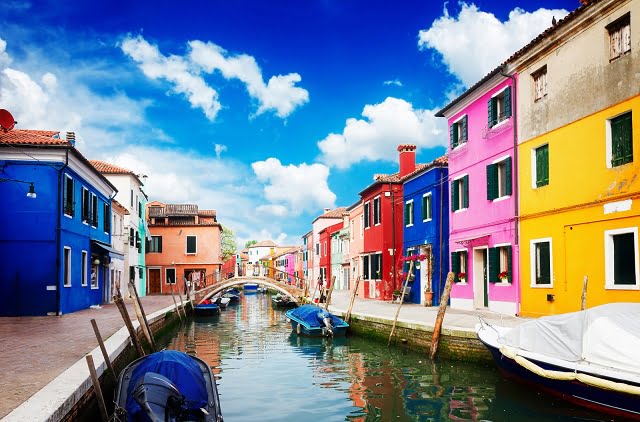
Italian customs and traditions play an important role in the culture of Italy. Although the country has experienced a wide range of cultural influences due to its proximity to many other countries, Italian culture remains largely distinct and unique from those of its neighbors. The various regions of Italy each possess their own dialects, music, food, traditional crafts and art. Moreover, centuries-old festivals still remain popular throughout the country, offering insight into the cultural history of Italians.
Food Customs Food is a fundamental part of Italian customs and traditions. Traditional meals involve courses such as antipasto (appetisers), primo piatto (first course), secondo piatto (second course), contorni (side dishes) and dolce (dessert) with ample servings of wine for adults. Many Italian families will still share home-cooked meals on Fridays or Sundays as a way to honor Catholic tradition in the country.
Furthermore, mealtime should always be seen as an occasion for laughter and conversation amongst family members to bring everyone together. Even outside this context though, food takes an important place socially when people meet up to eat at cafes or restaurants, it serves as the main form of entertainment as well as sustenance.
Arts & Crafts Arts and crafts are an integral part of Italy’s cultural legacy due to artistic feats achieved during different periods such as the Renaissance era where painters like Michelangelo created artwork that is renowned today. There are numerous handcrafting techniques passed onto younger generations today from older ones which include florentine marquetry work which involves using small pieces of wood set in ornate designs or paper marbling for bookcover decoration using special paints and tools.
Additionally, Italians sometimes take part in crafting workshops facilitated by artists who teach pottery making classes or jewellery designing sessions as a way for people to learn new skills within existing cultural settings.
Overview of Italian Cuisine
Italian customs have always had a profound influence on the country’s cuisine, and that reflects itself throughout history. From the ancient times of Rome to modern day, Italian culinary traditions are firmly rooted in their culture.
Italy is home to a large variety of regional dishes, so it’s no surprise that one can find numerous variations on classic Italian dishes-from thick lasagna from Bologna and creamy polenta from Milan, or paper-thin pizza from Naples and stuffed egg bread of Umbria. The high quality ingredients used to create these delicious dishes change all across Italy, with different areas utilizing herbs, vegetables, dairy products, meats and olives specific to each location.
Herbs are always a staple in Italian cooking – olive oil is essential for creating sauces while garlic adds intense flavor to many dishes. Popular vegetables used for flavoring include tomatoes, which play an important role in pizzas as well as other specialties like veal Parmigiana. Cheese comes into play with almost anything from the cheeses ravioli to slices on pizza; Parmesan Reggiano being the most popular dairy product used by Italians.
Seafood is found widely throughout the coastlines of Italy but they feature more prominently in certain regional cuisines such as Liguria or Campania. Meats such as beef steaks or veal cutlets add depth and savoriness to many meals while salamis hold an important place too-mortadella being especially popular due to its origins in Bologna.
Cooking styles in Italy also vary continentally but rustic comfort remain at its core. Ragu sauce cooked for hours over low heat creates flavorful flavorsome tomato sauces and thick layers of lasagna is layered meticulously before assembling it all together with Ricotta cheese adding creamy flavor profiles.
Grill equipment is hugely popular while thin flat plates are spun up into Neapolitan style pizzas quickly then slid onto wood ovens heated up over coals or logs entirely fueled by wood for a singularly unique experience when cooking traditional pizza margherita with simple tomatos, basil and mozzarella di buffalo atop it all.
On top of this summer months will find entire sides of beef slow cooked over charcoal pits for party-style dining experiences where everyone gathers around the fire feasting upon this meaty treat. At its heart, Italian cuisine seeks simplicity-fresh ingredients enhanced by solid execution rather than heavily relying on complicated techniques created by masterful chefs surpassing generations’ masterpieces combined with typical vibrant flavors rarely paralleled outside of Italy.
The Significance of Food in Italian Culture
Food is a central part of Italian culture and has been for centuries – not just as sustenance, but as an important part of religious and cultural celebrations, special dining rules, and unique family practices. Italians take their food seriously, and it’s impossible to understand this Mediterranean country without examining the interaction between food and its people.
Food plays an essential role in Italy’s diverse religious history. In addition to observances within Roman Catholicism, such as religious feasts celebrating meatless Fridays or Christmas candy-making sessions, there are special traditions concerning New Year’s Day food offerings that vary from region to region. These customs have their origins in ancient pagan festivals in which offering fresh fruits or vegetables was believed to bring luck for the coming year.
Family traditions around mealtimes also play an important part in Italian culture. For traditional Italian families who live close together, dinner is seen as an important time of day to reconnect with one another after the hustle of modern life.
Special dinner etiquette such as taking turns to serve dishes and only talking about lighthearted topics can also help to bring families closer together during meals. Some foods are also associated with major events like marriage or birthdays – if an Italian family member gets married or hits a milestone birthday, you can guarantee that pasta will be served at the celebration.
Common Italian Customs Involving Food
- Participation in religious feasts that involve eating without meat on certain days.
- Making New Year’s Day offerings of fruit or vegetables to bring luck.
- Using dinner time etiquette such as taking turns serving dishes and only talking about lighthearted topics during meals.
- Serving special foods at major events such as marriages, birthdays or anniversaries.
Celebration of Major Festivals and Holidays
Italy is well known for its celebration of Festivals and Holidays, from religious to traditional. Amongst its most popular are:
- Carnevale di Venezia – represents the end of winter carnival festivities where masks and costumes are worn.
- Ferragosto – a holiday celebrated on August 15th in honour of the Assumption.
- Natale – a festive season celebrated near Christmas Day to celebrate the birth of Jesus Christ.
- Epifania – also known as Three Kings’ Day, which celebrates Three Wisemen bringing gifts for newborn Jesus Christ.
- Pasqua (Easter) – A religious celebration commemorating Jesus Christ’s resurrection from death that is celebrated with feasts.
In addition to religious and public holidays, several Italian traditions are held during different times of the year. One example is Palio di Siena, a horse race that takes place every July 2nd in Siena. Traditional costumes such as ‘Florentine’sheep skin-garment and ‘Napolitan’hats can be seen all around.
The city also celebrates La Festa della Repulicca Italiana, an annual national holiday that commemorates the day Italy became a republic back in 1946. It focuses on celebrating Italian history and heritage related events such as parades and concerts.
Another renowned event is Giro D’Italia cycle race, which spans three weeks between May-June each year. It passes through all major cities around Italy and involves professional cyclists completing 3 or more stages through each provinces over 23 days total. Many famous cycling champions have won this race over the years, thus making it one of Italy’s most prominent events locally and internationally alike.
Language
The Italian language is an important aspect of the vibrant customs and traditions in Italy. It serves as the common method of communication between people from different regions of the country. However, what many may not be aware is that there are differences in dialects, word usage, gestures, and slang throughout Italy.
Italian dialects have been around since the beginning of Italy as a single nation entity. Each dialect contains unique linguistic features that are distinct to the region where they originated.
For example, Tuscan has influenced much of the standard language that is spoken today with its clear pronunciation and easy-to-understand grammar rules. Taking cues from regional languages like Sardinian or Venetian make up many expressions and phrases used by Italians to convey emotions or opinions during social interactions-the most popular being ‘bella figura’, which means presenting yourself in a confident light regardless of the situation.
Gestures play an integral role in Italian traditions and can easily give away a person’s mood or thoughts if misinterpreted. The ‘figaccio’ gesture-where one makes a fist with all fingers except for the thumb-is used to communicate frustration or anger when someone has said too much without considering any consequences.
Whereas rolling eyes subtly suggests one should stop talking due to their foolish behavior over something minorly embarrassing occurs often among teenagers but can also signal disbelief when presented with something irrational rather than being disrespectful.
Lastly, having a good understanding of Italian slang helps to build relationships within everyday conversations and jokes between friends or families more efficiently because it allows one to grab essential nuances of conversations easier when it comes about engaging topics such as football teams or food recipes while listening to them in life situations like sitting through dinner table conversation.
Some popular slang terms include ‘bischero/bischera’ for someone who talks too much trash/gossip; ‘pollo’ for an easy target; and ‘scocciatore/ scocciatrice’ referring to anyone who constantly interrupts others without permission throughout conversations-most likely those who tend to be very talkative.
List Of Popular Italian Customs And Traditions
- Coffee Culture: Many towns have bars where people will gather for coffee throughout the day.
- Family Dinners: You will find family dinners and lunches which contain multiple courses.
- Gelato: One cannot go wrong with having a nice cool Gelato.
- Drinking Limoncello: Every bar, restaurant, beach resort will offer some kind of Limoncello.
- Pompeii Visit: An historical visit through the ruins of Pompeii remains very popular among tourists.
Influence of Pop Culture on Daily Life in Italy
Italy has always been a nation renowned for its art and culture and this influence is certainly evident in the nation’s customs and traditions. Music, movies, television, and art have all contributed to popular culture today in Italy.
Firstly, let’s look at music. Opera dates back centuries ago in Italy and it remains hugely popular to this day. Italy has given birth to some of the greatest operatic voices such as Enrico Caruso, Renata Tebaldi, Luciano Pavarotti and Mario Del Monaco.
Many of these operatic pieces are still performed to captivated audiences around the world today. In addition to opera, Italian folk music has been around for centuries with roots stretching back into Roman times. This traditional tunes are often a source of comfort for Italians everywhere.
Moving onto movies; again this is an integral part of Italian culture today under the name of ‘Neorealism’ – “an influential movement between 1943 and 1952 producing gritty films about working-class life that featured nonprofessional actors”¹ Famous directors such as Federico Fellini and Roberto Rossellini have had an immeasurable influence on Italian cinema over the years.
Movies like Rome Open City (1945) adding fuel to post-war resistance boost morale in 1945 with its depiction of courage of ordinary people who fought for Italian democracy after World War II².
Finally, modern art continues to dazzle visitors thanks to well-known artists like Michelangelo di Lodovico Buonarroti Simoni⁴ who achieved global fame with his sculpture “David” created between 1501-1504 which can be seen in Florence. There is also Leonardo da Vinci whose drawing Vitruvian Man is considered one of the most significant works from the Renaissance period⁵ – it truly encapsulates his polymath genius across science, engineering mathematics not just art itself.
Takeaways
- Opera remains hugely popular
- Italian Folk Music dates back into Roman Times
- Neorealism was an influential movie movement between 1943-1952
- Federico Fellini & Roberto Rossellini’s films have had an impact on Italian Cinema
- Michelangelo di Lodovico Buonarroti Simoni’s ‘David’ sculpture is known worldwide
Leonardo Da Vinci’s Vitruvian Man drawing encapsulates his polymath genius.
Interaction with Family and Friends
In Italy, people take the time to interact with family and friends whenever possible. When Italians greet one another, they take the opportunity to hug, kiss, and often speak nostalgically about their relationships. Expressions of love such as “Ti amo” (I love you), or “Ti voglio bene” (I really care about you) are commonly used. This form of expressing is normal for both close family and for acquaintances.
Sometimes Italians will also play practical jokes on one another when greeting each other, or when saying goodbye. These jokes can range from tickling or running away to more elaborate pranks such as surprising a friend with a sudden loud noise or a funny story. Such antics not only create laughter but also help demonstrate the strong bonds between family and friends in Italian culture.
Eating Customs
For Italians food is an essential component of daily life. For meals there is often an antipasto plate served as an appetizer followed by a course of pasta with either a sauce-based dish or grilled vegetables like zucchini or bell peppers.
A salad may be served after the main course followed by cheese and fruit for dessert accompanied by either coffeeor tea depending on preference. At dinner it is usually a special occasion that requires time for relaxed dialogue along with quality food.
When dining out in Italy, customers are expected to leave tips of around 10% for good service. It’s also important to keep in mind that in Italy it’s polite to stay seated after your meal until you indicate that you would like the restaurant to prepare your bill/check. After paying your bill, don’t be surprised if someone calls out ‘Arrivederci.’ an expression that signifies goodbye but quite literally translates into ‘Until we meet again’.
Expectation of Respect
Italians tend to have high expectations about respect when interacting with each other which means that great care should be taken when addressing members of different generations within society. For example if someone from Italy asked you ‘what do you do?’
– instead of answering ‘I work as’ they might expect you reply ‘My job is” In both cases you are defining who you are but expressing it differently act as reflection of your respect and knowledge toward customs within Italian society. This stratification can be seen throughout Italian culture where age has its privileges, specifically respect for those who have been around longer than most.
The Climax and Conclusion of Italian Customs and Traditions
Italian customs and traditions continue to hold a deep importance in many Italian households. One such tradition, La Festa della Repubblica, is held annually to commemorate Italy’s independence and is widely celebrated with fireworks, parades, and public ceremonies all throughout the country. Additionally, it is customary for Italians to take part in religious festivities that honor their patron saint or the local relics of their faith.
For example, people travel from all over Italy to Rome on June 29th for the Feast of Sts Peter and Paul, a two-day celebration of their respective legacies. Special masses are held at the Vatican as well as other churches throughout Rome.
The exhilarating allure of food in Italian culture is similar to no other. Family meals revolve around extended conversations which allows each family member to express their individual opinions or stories while reinforcing mutual values and beliefs. Celebrations between families often involve close-knit dinners where guests wait eagerly for traditional meal staples such as risotto or lasagna followed by dessert specialties like panettone and cassata siciliana cake.
An additional beloved holiday that takes place throughout Italy is Carnevale di Venezia which invites its attendees throughly dressed up in elaborately handcrafted masks with feathers occasionally adorned with horns. A stampede of revelers fill up the historically rich streets during this both somber yet jovial event, delving into early morning mass gatherings that last until dusk time activities ensue accompanied by festive music and carnival rides fit for every age range.
Furthermore these parties conclude with a splendid parade featuring musicians whose enthusiastic tunes resonate well into nightfall, leaving beautiful memories behind for those that particpated in them.
No matter how diverse Italian customs may be depending upon region to region this host country continues to share varied ways of celebrating with locals and visitors alike. What remains intact through each custom are characteristics lauded far beyond national borders such as devotion towards passionated cuisine, intimate family moments, showmanship, createvity/arts along with toleraance and respect amongst citizens.
This transcendence makes Itlay one of the world ‘s emblematic places teeming with encapsulating customs that will stay alive for generations to come.




